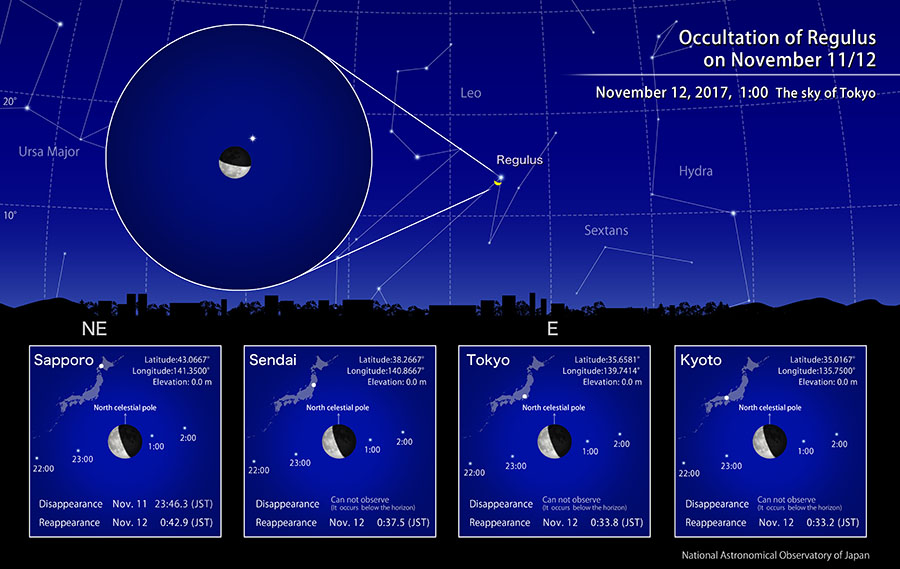Occultation of Regulus on November 11/12 (November, 2017)

Look for Regulus Appearing from the Edge of the Moon
The 1st magnitude star Regulus shines at the chest of the constellation Leo. Leo is known as a spring constellation. But already in November Leo rises in the eastern sky around midnight. As the date changes from November 11 to November 12, Regulus is covered by the waning crescent moon. This phenomenon is called an “occultation of Regulus.”
For this time’s “occultation of Regulus,” the “disappearance,” when Regulus is covered by the Moon, cannot be seen in most areas of Japan because it occurs below the horizon. Also from Kyushu and regions further west, we cannot observe the “occultation of Regulus” at all because the moment of "reappearance" when Regulus emerges again from behind the Moon occurs below the horizon. On the other hand, from Sendai, Tokyo, Kyoto, etc., Regulus shines in the lower eastern sky, but you can observe the "appearance" when Regulus appears from behind the rising Moon. The full occultation from disappearance to reappearance can only be observed from a limited area including Hokkaido.
Here are the predicted times for the occultation of Regulus at major locations in Japan.
| Location | Disappearance (Elevation of Regulus) | Reappearance (Elevation of Regulus) |
|---|---|---|
| Naha | ------ | ------ |
| Fukuoka | ------ | November 12, 0:32.3 (0.1 deg) |
| Kyoto | ------ | November 12, 0:33.2 (4.9 deg) |
| Tokyo | ------ | November 12, 0:33.8 (8.4 deg) |
| Sendai | ------ | November 12, 0:37.5 (10.3 deg) |
| Sapporo | November 11, 23:46.3 (2.0 deg) | November 12, 0:42.9 (12.2 deg) |
In the above table “----” indicates that we cannot observe the event because it occurs below the horizon.
This occultation of Regulus does not seem to have good conditions for observation. But Regulus appears from the dark edge of the Moon because the occultation is caused by the last quarter Moon. If you peek through binoculars, you can observe shimmering Regulus shining close to the Moon without getting lost in the moonlight, even though it is just after “reappearance.” It might be interesting to compete to see who can find Regulus first, appearing from the dark edge of the Moon.
Reference: Ephemeris Computation Office
With the “Sky Viewer” you can easily explore the appearance of a typical urban night sky (planets and constellations are visible). The Celestial Phenomena section of the glossary explains the planetary phenomena terms: greatest elongation, opposition, conjunction, stationary, etc.